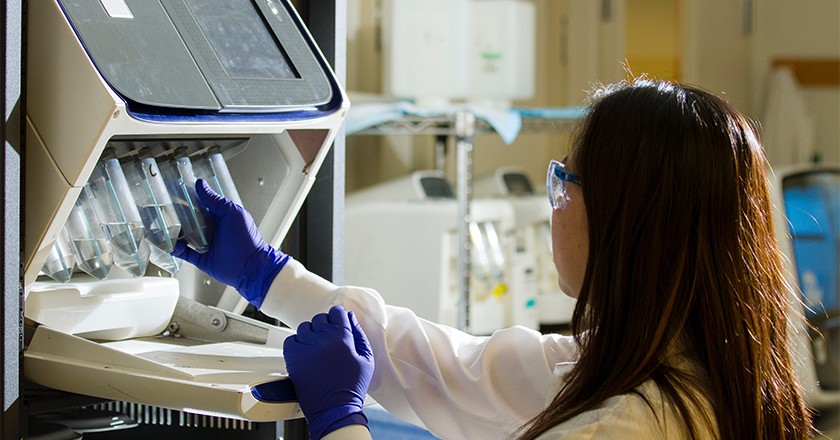This webinar was originally recorded on March 10th, 2020. If you’d like to view the recording, click here.
In our continuing series on COVID-19 (Coronavirus), we partnered with Dr. Paula Kavathas, Professor of Laboratory Medicine and Immunobiology at the Yale University School of Medicine, to learn more about how viruses work, how the body responds to the invaders, and impact of vaccines on disease prevention.
Below is a summary of the webinar Dr. Kavathas gave for us on March 10th, 2020.
What are Viruses?
Viruses are extremely small, which was demonstrated by comparing one to human cells (eukaryotic cells).
The cells of our body have a cell membrane,for keeping things in and invaders out, a nucleus where the DNA is located, and other organelles for producing energy, proteins, and more. Bacterial cells are tiny. Mentally compare a bicycle to a bus – that’s how much smaller bacterial cells are to most eukaryotic cells.
Viruses are a fraction of the size of bacterial cells. Take our image of a bicycle next to a bus. If you added a toy car to that lineup, the toy car would be the virus.
Viruses are composed of a viral shell, or envelope. Within that shell is either RNA or DNA, depending on the type of virus.
Viruses are characterized by some key features:
- They infect host cells if the cells have a molecule to which the virus can bind or attach
- They multiply inside host cells by taking over the machinery of their host cells
- They replicate exponentially
- They spread to new organisms(i.e., people) before the organism dies from the infection
Virus Seasonality
Many respiratory viruses that cause the common cold or the flu affect populations in a seasonal fashion.
The best example of this phenomenon are the rhinoviruses,viruses that account for more than 50% of all hospital respiratory viruses. While individuals come in with the illness caused by these viruses throughout the year, the numbers spike during the colder autumn and winter months. Other coldviruses follow this pattern, hitting their highest number of infections during the autumn and winter months.
Researchers are trying to determine if the newest coronavirus (SARS-CoV2 causing COVID-19 disease) follows a similar seasonal pattern. As the northern hemisphere warms in the next few months, we’ll see if the changes to the weather have any impact on the ability of the virus to spread and infect individuals.
Dr. Kavathas then showed a chart demonstrating that individuals with respiratory viruses can be asymptomatic (no illness) and yet spread the virus.
She described a study that followed 26 families and took nasal swabs weekly from each member of the family throughout the course of the year. Children appeared to be positive 50% of the time, and this trended downward with age. The troubling piece of this study is that asymptomatic people were still found to be hosting the virus, showing that viruses, and COVID-19 in particular, can spread through people who don’t appear sick.
What Does COVID-19 Do?
This coronavirus is like many others. COVID-19 attacks both the upper and lower respiratory tracts of individuals. If the coronavirus gets into the upper respiratory tract, the person will display symptoms of the common cold, which include a runny nose, sore throat, headache,and nasal congestion.
When the coronavirus enters the lower respiratory tract, it starts to cause much more damage and trouble for the infected person. As the virus continues spreading through the lower respiratory tract and inflammation occurs, fluid builds up in the lungs. This interferes with the vital gas exchange the lungs are responsible for performing.
In more severe cases, individuals will develop Acute Respiratory Distress Syndrome (ARDS), and become very ill because many parts of the body are receiving less oxygen than they normally do.
How the Body Fights Viruses
How the body responds to viruses is different than how it responds to other types of invaders, such as bacteria or parasites. Dr. Kavathas made the analogy of how you’d react differently to a bug flying into your room than a raccoon jumping through the window.
For an immune response to start in the body,it first must recognize that a microbe is present. After doing this, it activates cells that participate in the body’s response to the pathogen. The body then fights the infection, stops the response after the infection is cleared, then repairs the damage from the infection and response.
The body’s immune response is more complex than those handful of steps, however. Generally, the body responds in one of two ways to an invading microbe.
First Response to a Virus
Innate response is one of the two ways the body and immune system fights foreign pathogens. Many animals, plants, and other lifeforms also use innate response to fight off infection. It’s quick,starting within hours of the pathogen being detected.
Receptors perform detection by recognizing structures present on microorganisms but not the host. You are probably familiar with other types of receptors such as receptors that detect smells or hormones. These receptors detect viruses and other pathogens.
Human cells have 60 different kinds of receptors for detecting microbes, including several for detecting COVID-19.
Say an epithelial cell (the kind that lines the upper respiratory tract) is infected by the coronavirus. The virus binds to a protein on the cell surface (ACE2) of epithelial cells and enters via an endosome (material couriers within the cell). The coronavirus then releases its RNA which binds to a receptor (MDA5). This sends a signal to the nucleus, and the cell begins producing interferons and inflammatory cytokines in response to the infection.
Cytokines are a critical part in the body’s ability to fight off pathogens. They are the way cells communicate with each other and how they alert each other to the presence of viruses, bacteria, and other pathogens.
The cytokines the cell releases inform neighboring cells of an invader’s presence. The cytokines themselves bind to a cytokine receptor on neighboring cells, which tells them to prepare for an attack. Interferons cause cells to make proteins and enzymes that will interfere with all aspects of the virus life cycle. Inflammatory cytokines lead to inflammation characterized by swelling, heat, pain, warmth, and recruitment of immune cells to help fight the infection.
Second Response
The body also fights off pathogens through adaptive response. This method is exclusive to mammals and has unique features, such as the ability to develop memory. It takes between 5 and 7 days for this type of response to kick off because it first must be alerted by the innate system. The cells in this response have receptors that are very specific for a microbe.
The adaptive immune system has two key cells:
- T cells which fight infection once they are activated
- B cells, which produce antibodies once they are activated
T and B cells travel between lymphatic vessels, lymph nodes, and blood vessels until they encounter foreign antigen material and interact with sentinel innate cells alerting them to the infection.
It’s important to note the difference between these two cells’ actions. T cells are like hunters, killing virally infected cells during the course of the infection. Most of them die after an infection has been cleared, but a few go on to survive and function as memory cells to help the body respond quickly the next time this pathogen tries to attack the body. T cells offer what’s referred to as “cellular immunity.”
B cells offer humoral immunity to pathogens.They have a receptor that binds to foreign antigen and then produce and secrete antibodies. Antibodies then circulate around the body, limiting the ability of the virus to infect cells. In the case of a coronavirus, antibodies bind to the spike proteins on the outside of the virus and limit the ability of the virus to infect a cell. Activated B cells either develop into memory cells, or produce antibodies for years.
Influences on Immune Response
Rarely are the human immune system and pathogens the only forces at play in these scenarios. Studies and researchers have found temperature, pollutants, smoking, lung disease, ageing, obesity,being immuno-compromised, and even genetics play significant roles in a person’s ability to fight respiratory infections.
The single most influential way to fight against viruses, however, are vaccines.
In the 20th century alone, smallpox killed 300 million people. Edward Jenner, back in the 1790s, already started vaccinating people by exposing them to smallpox’s cousin, cowpox.
In the 1960s, the world started a campaign to eradicate the virus. By 1977, global vaccination efforts were successfully eradicated smallpox. Since smallpox only infects humans, the virus was wiped out. Coronaviruses, unfortunately, infect bats and other animals so we can’t eradicate them through vaccination. We can, however, prevent illness.
Vaccines 101
Vaccines work because they provide our bodies with a head start.
Vaccines expose your body and its immune system to the pathogen without causing illness. Some employ inactivated or weakened microbes or components of the microbe, and induce the body to create the memory cells and the antibodies we discussed earlier. (DNA vaccines are currently being research and show some promise).
While vaccines help an individual’s immune system, they also help those of the people in the community at large. When enough people in a community are vaccinated against a disease, a herd immunity develops. This greatly limits the reach of the microbe, and protects those who aren’t able to receive vaccines or are otherwise at a greater risk for infection.
In relation to COVID-19 (Coronavirus), a vaccine, however, is mostly likely around 12 months away from being available for widespread use due intense development process. The process is for a good cause, though, as it ensures the vaccine’s safety and efficacy once it’s in use.
The Immune System and Viruses
In times of crisis, data is extremely important. Thanks to the information Dr. Kavathas provided in this webinar, all of us — at both personal and professional levels — can make better decisions over the next few weeks and/or months as the coronavirus pandemic continues.
A part 3 in this series featured members of the Veoci solution team with experience preparing for an event like the COVID-19 pandemic. Watch it to see their best practices, lessons from experience, and their approaches to managing a response to COVID-19.








